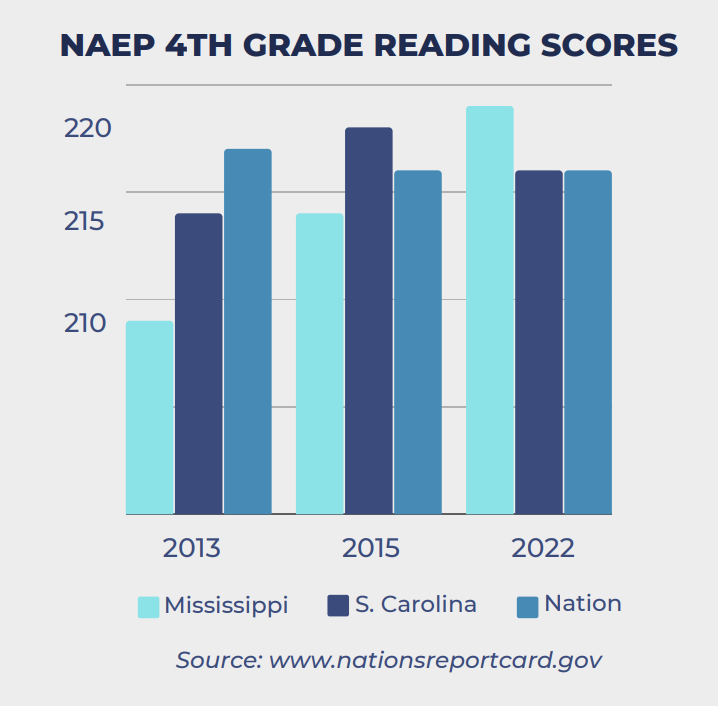The good and food for thought
May 7, 2024By Alan Cooper
Publisher
WhosOnTheMove.com
Recently I reached out to some contacts from across the state and asked them to send me:
- one metric that they are proud of
- one metric that causes concern for SC
The areas of focus: entrepreneurship, commercial real estate, education, manufacturing, logistics, the arts, access to capital.
The purpose was to highlight progress across the state and to come up with discussion around our areas of opportunity. I call it the ‘good and the food for thought.’ You can hear a version of this on the South Carolina Business Review which aired on Monday, May 6.
Education – from the SC Department of Education
The good
South Carolina students saw a 7-point increase in reading proficiency and a 2-point increase in math in the 2022-23 school year. The jump in reading is especially encouraging, as South Carolina moves to fully align with the Science of Reading, because literacy is the foundation of all other learning.
The Science of Reading program has transformed education in Mississippi over the past decade. In 2013, Mississippi passed a law that ensured all K-3 teachers were trained in the Science of Reading using an intensive literacy training known as Language Essentials for Teaching Reading and Spelling (LETRS). This investment has paid huge dividends for Mississippi students and is closing achievement gaps across the state.
In 2013, Mississippi lagged behind SC. In 2022, Mississippi passed South Carolina, and the nation.

I encourage South Carolinians to learn more about the Science of Reading by following this link.
Food for thought
Despite recent gains, only 54% of South Carolina students read at grade level and just 41% meet math standards, signaling a steep challenge ahead.
“The SC Department of Education is committed to addressing this through strategic investments to support proven strategies to move the academic needle:
- high-quality learning and higher pay for our teachers
- high-quality materials for them to use in their classrooms, and
- instructional leadership development for teachers and principals
With those key pillars in place, I have lot of hope for our students’ future!” – Superintendent of Education Ellen Weaver.
The Arts in South Carolina
The good
I am a strong believer that the arts are a key component of 1) anyone’s education and 2) a city’s economic development. An arts education fosters collaboration, creativity, critical thinking skills and supports success in other subjects. A vibrant arts scene in a city is critical to attract locals and tourists.
Arts Grow SC is a three-year partnership between the South Carolina Department of Education and the South Carolina Arts Commission to help public schools throughout the state address pandemic related learning loss with proven, arts-based learning initiatives.
Adequately-funded arts learning programs through the Arts Grow SC partnership went from 9,900 K-12 student participants in year one to 209,400 K-12 participants after ramping up for year two. This partner-driven approach, across all its initiatives, special projects, and grant programs, equips the future of our state with creativity, hope and engagement in the classroom thanks to the power of the arts.
Food for thought
The federal funding behind Arts Grow SC was only for three years.
“We have data to prove effectiveness, and legislators are receptive, but work must be done on the state level to keep Arts Grow SC programs at full strength to benefit the most students,” said David Platts, Executive Director of the SC Arts Commission.
Entrepreneurship
The good
For this section, I reached out to our partners at the South Carolina Research Authority.
“We are proud to be part of a robust entrepreneurial ecosystem that provides everything startups need to be successful. SCRA Member Companies and SC Launch, Inc. Portfolio Companies pay an average salary of $91,000 annually, 70% higher than the state’s average. This produces a ripple effect in our state’s economy,” said Bob Quinn, President and CEO of SCRA.
Food for thought
Although there is a solid base of capital support for early-stage companies in all sectors, South Carolina struggles with attracting capital for mid-to-late-stage companies from venture capital and private equity firms.
Several initiatives are underway to help address this, including, but not limited to, the state’s Science and Technology Plan which was published in June 2022. Specific targets have been set for ‘Innovation and Entrepreneurship’ as well as ‘High-Tech Industry Growth’ and ‘Research Competitiveness’.
Also, the S.C. Department of Commerce and SC Launch, Inc.’s investor network is bringing together venture firms throughout the Southeast.
Access to capital – from Charlie Banks, President, VentureSouth
The good
In a historically difficult state for entrepreneurs to raise capital, VentureSouth has invested over $20M in 23 South Carolina companies throughout the last handful of years. Not only are entrepreneurs starting scalable companies in the state, they are finding the capital they need to execute their business plans here as well.
Food for thought
The one metric that needs work is the South Carolina Angel Tax Credit. “We believe the credit is inadequate for the amount of activity, and the way the State is administering the credit is flawed. Given the influx of capital coming from the State Small Business Credit Initiative (SSBCI) program, which requires a 1:1 match with private capital, the tax credit program needs to be a top priority to address.”
Commercial Real Estate
The good
One metric that is driving growth in SC is the continuing investment by the state into infrastructure (roads, ports, rail). This growing investment is attracting developers and investors of manufacturing and warehouse properties statewide.
Food for thought
The deterioration of the suburban commodity office market is of concern in all three markets (Columbia, Greenville, Charleston). This subset of the office market is in trouble and will not be likely to recover for many years.
In conclusion
Let’s use metrics to continue to develop strategies to move our state forward.














